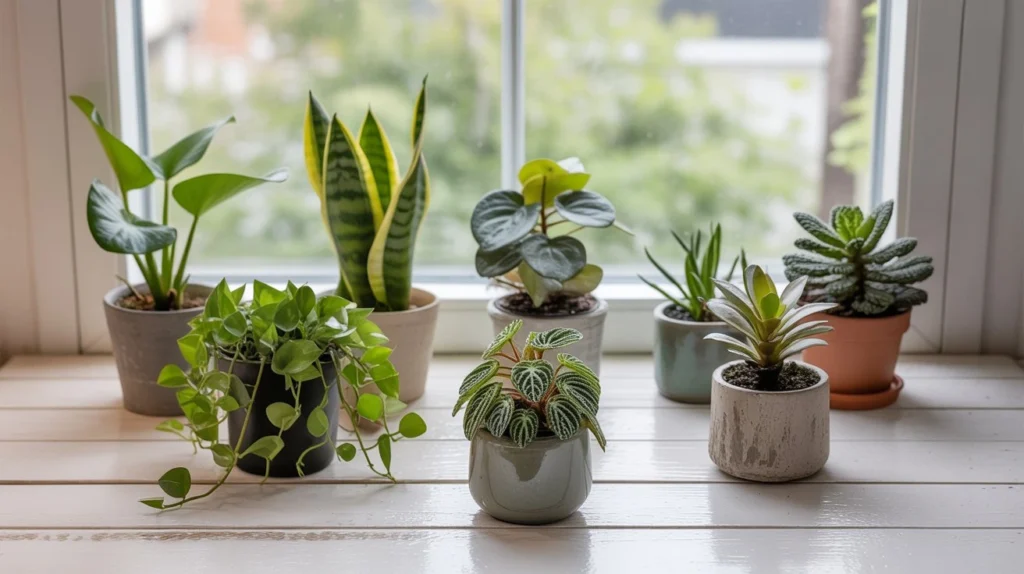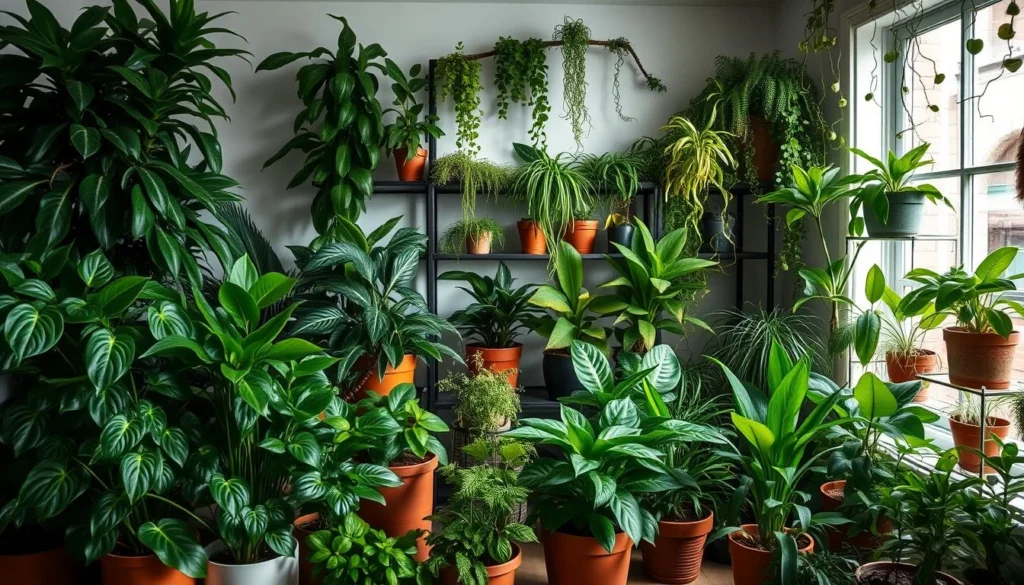
Did you know some indoor plants can grow well in dark places? This is great news if you’ve had trouble keeping plants alive in dark spots.
The Pothos and Snake Plant are among the toughest and easiest to care for low light houseplants. They’re ideal for adding life to your space.
By picking the right plants, you can enjoy the perks of having plants, even in dimly lit areas. This way, you can have a greener space, no matter the light.
Table of Contents
Why Dark Room Plants Are Perfect for Your Home
If you’re having trouble keeping plants alive in your dimly lit home, you’re not alone. Many of us face challenges in keeping a lush indoor garden due to lack of natural light. But, there’s a solution. Dark room plants are made to grow well in low-light spaces, making them perfect for homes with limited natural light.
What Qualifies as a “Dark Room”
A dark room gets little natural light, often less than 100 foot-candles. This includes basements, bedrooms without windows, or living rooms with little sunlight. Knowing what a dark room is helps you pick the right plants for your space.
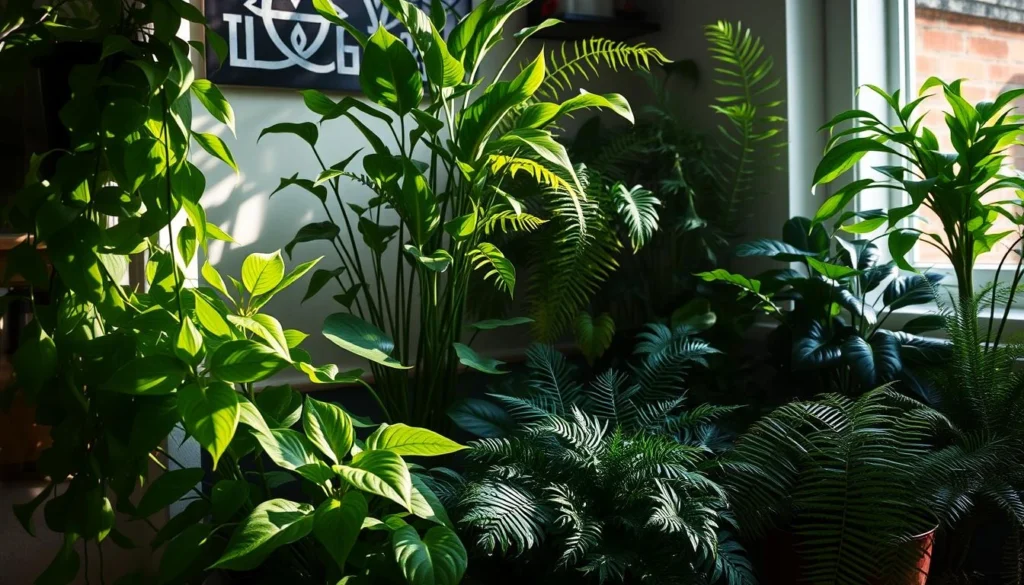
How Plants Adapt to Low Light Environments
Plants adjust to low light by changing how they grow. Some plants make their leaves smaller or produce more chlorophyll to catch more light. These changes help plants survive and even grow well in low light, making them great for dark rooms.
Best Dark Room Plants for Beginners
Dark rooms don’t have to be plant-free zones. There are many low maintenance plants for dark spaces great for beginners. These plants are forgiving and easy to care for, perfect for those new to indoor gardening.
Snake Plant (Sansevieria)
The Snake Plant is a top pick for dark rooms. It thrives in low light and purifies the air, making it ideal for indoor spaces.
Varieties and Care Requirements
There are many Snake Plant varieties, from small to tall. They need little water and can handle neglect. This makes them great for busy people or those new to plant care.
ZZ Plant (Zamioculcas zamiifolia)
The ZZ Plant is a shade tolerant indoor plant that’s hard to kill. It has glossy leaves and can live in low light.
Growth Patterns and Maintenance
The ZZ Plant grows slowly and needs little care. It’s perfect for those who forget to water, as it can go long without water.
Pothos (Epipremnum aureum)
Pothos is a versatile, low maintenance plant that does well in various lights, including dim. It’s easy to propagate and can climb or trail.
Different Varieties and Propagation Tips
Pothos has many varieties with different leaf colors and patterns. To propagate, just cut a stem section and put it in water or soil. It’s a great plant for beginners to practice propagation.
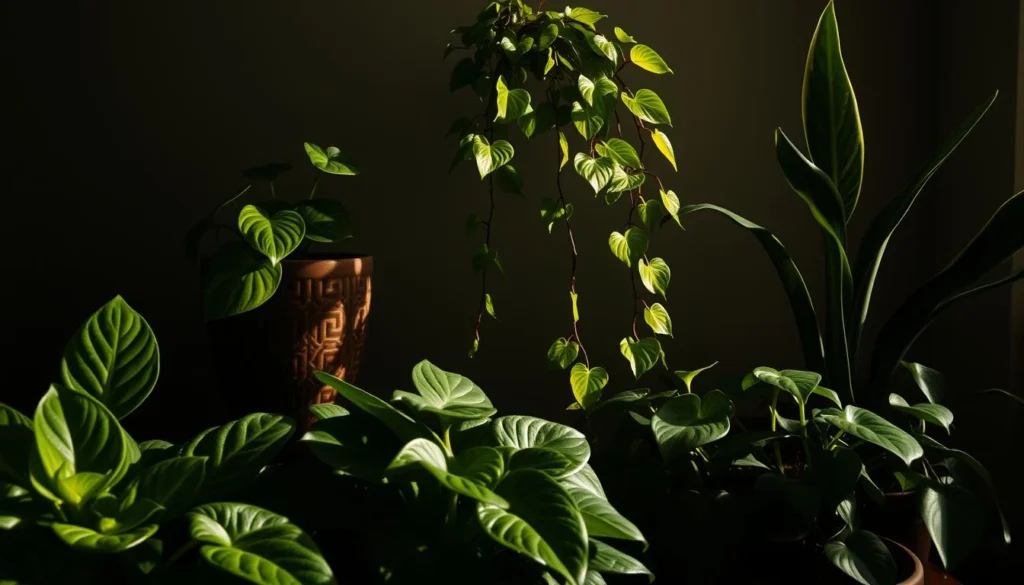
These plants are ideal for beginners starting their indoor garden in dark rooms. With their ability to thrive in dim light, you can enjoy indoor gardening even in low-light spaces.
Elegant Foliage Plants for Dim Spaces
Looking to brighten up dimly lit areas? Try adding foliage plants that love low light. These plants not only survive but also thrive, bringing beauty and elegance to any room.
Chinese Evergreen (Aglaonema)
The Chinese Evergreen is a top pick for low light spots. Its attractive leaves and low light tolerance make it an excellent indoor plant for low light conditions.
Color Varieties and Placement Tips
Chinese Evergreen comes in many colors like silver, gold, and green. For best growth, place it in indirect light and keep watering consistent. It’s a versatile plant that fits well in homes and offices.
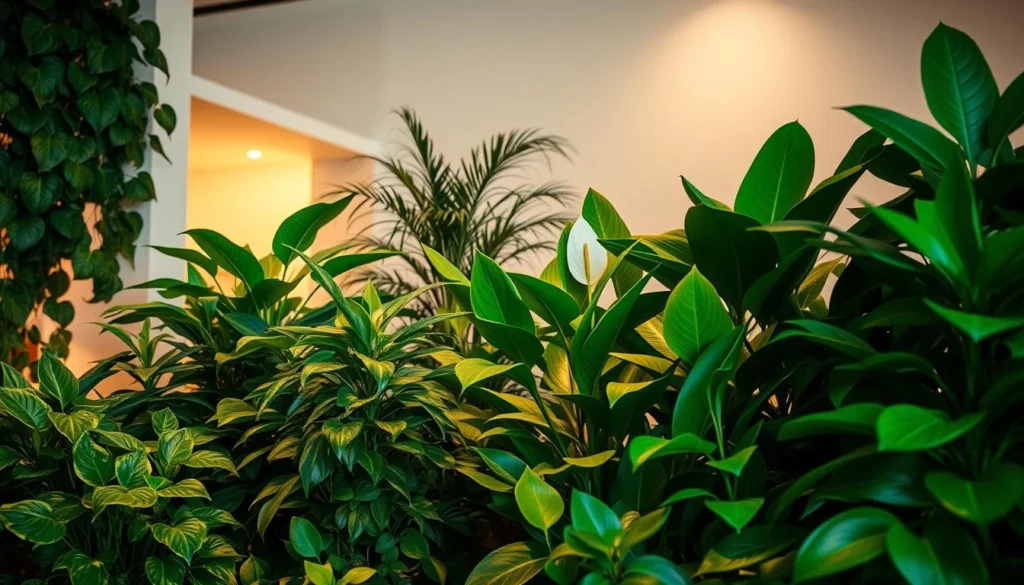
Cast Iron Plant (Aspidistra elatior)
The Cast Iron Plant is known for its toughness and ability to grow in low light. It’s also easy to care for, needing less water and attention.
Why It’s Called the “Indestructible” Plant
This plant gets its nickname for its ability to survive neglect. It can handle a variety of conditions, from low light to infrequent watering. It’s ideal for busy people or those new to plant care.
Peace Lily (Spathiphyllum)
The Peace Lily is a beautiful option for dim light. It boasts white blooms and dark green leaves, adding elegance to any room.
Flowering Habits in Low Light
While the Peace Lily blooms in low light, it might not bloom as often as in brighter spots. But its foliage stays attractive all year, bringing constant beauty.
These plants are not just pretty; they also purify the air. Adding these plants that thrive in dim light makes your home healthier and more welcoming. Enjoy the benefits of indoor gardening even in the darkest corners.
Surprising Flowering Plants That Thrive in Low Light
You don’t need a bright room to enjoy flowering plants. Some varieties do well in low light. These plants add color and vibrancy to dark spaces.
Moth Orchid (Phalaenopsis)
The Moth Orchid is great for low-light areas. It has elegant white blooms that last months. Water it weekly and fertilize monthly to keep it thriving.
Bloom Maintenance in Dark Conditions
For blooming in low light, keep the temperature between 65-75°F (18-24°C). This helps your Moth Orchid bloom longer.
Flamingo Flower (Anthurium)
The Flamingo Flower impresses with its heart-shaped blooms in red, pink, and white. Water it weekly and keep it humid to keep it happy.
Encouraging Blooms with Minimal Light
Use balanced fertilizer during the growing season to encourage blooming. This promotes healthy growth and flowers.
Bromeliad Varieties
Bromeliads include pineapples and air plants. They have bright, long-lasting blooms and thrive in low light. Water them weekly and provide bright, indirect light.
Colorful Options for Dark Corners
Bromeliads come in pink, red, and yellow. They brighten dark rooms. With care, they bloom for months, lighting up your space.
Unique Dark Room Plants with Striking Features
Dark rooms don’t have to be dull. You can add life with striking low-maintenance plants. These plants not only survive in low light but also add elegance and uniqueness to your space.
Prayer Plant (Maranta)
The Prayer Plant is known for its fascinating leaf movements. At night, its leaves fold up, giving it a praying appearance. This unique feature makes it a great conversation starter.
Fascinating Leaf Movements
The Prayer Plant’s leaves are not just visually appealing, but they also have a unique behavior. This plant thrives in low light and requires minimal care, making it perfect for dark rooms.
Calathea Varieties
Calathea plants are renowned for their stunning patterns and textures. They come in a variety of colors and patterns, adding visual interest to any room.
Patterns and Textures for Visual Interest
With their beautiful foliage, Calathea plants can brighten up a dark room. They are relatively low maintenance and can thrive in low-light conditions.
Rex Begonia
Rex Begonia is another striking plant that can add color to your dark room. Its leaves are known for their vibrant colors and unique patterns.
Maintaining Vibrant Colors in Low Light
To keep your Rex Begonia thriving, ensure it gets the right amount of moisture and humidity. This will help maintain its vibrant colors even in low-light conditions.
| Plant | Lighting Needs | Maintenance Level |
|---|---|---|
| Prayer Plant | Low Light | Easy |
| Calathea | Low Light | Moderate |
| Rex Begonia | Low Light | Moderate |
Essential Care Tips for Low Light Houseplants
To keep your indoor plants for low light thriving, it’s essential to understand their unique needs. These plants, while more forgiving than those needing direct sunlight, require specific care to flourish.
Watering Practices for Dark Room Environments
Watering is key for plants that thrive in dim light. Overwatering can harm them, causing root rot and other problems. Check the soil moisture by inserting your finger into the soil up to the first knuckle. If it’s dry, it’s time to water.
Avoiding Common Overwatering Mistakes
Avoid watering on a schedule; instead, water based on the plant’s needs. Make sure the pot has good drainage holes to prevent waterlogged soil.
Fertilizing Schedule for Low Light Plants
Fertilizing low light houseplants is vital for their nutritional needs. Use a balanced, water-soluble fertilizer during the growing season (spring and summer). Dilute the fertilizer to half the recommended strength to avoid burning the roots.
Seasonal Adjustments for Optimal Growth
Adjust your fertilizing schedule according to the season. In the fall and winter, when plants are dormant, reduce fertilizing to once a month or less. This is because they require fewer nutrients during these seasons.
Pest Prevention in Low Light Conditions
Pests can affect plants in low light conditions. Regularly check your plants for signs of pests like spider mites, mealybugs, and scale. Use insecticidal soap or neem oil to treat infestations.
Identifying and Treating Common Issues
Regularly inspect your plants for signs of stress or disease. Yellowing leaves can indicate overwatering, while droopy leaves might signal underwatering. Adjust your care routine as needed.
Creative Ways to Display Your Dark Room Plants
Displaying dark room plants in creative ways can make any room look elegant. You can make your space more beautiful by using new ways to show off your plants.
Vertical Gardens for Space Optimization
Vertical gardens are great for saving space and adding greenery to your home. Wall-mounted planters or trellises can create a beautiful display that catches the eye.
DIY Wall Mounting Ideas
Think about using reclaimed wood or metal brackets for a unique planter. Old pallets can also be turned into a rustic vertical garden.
Terrarium and Container Ideas
Terrariums and containers are versatile for showing off dark room plants. Pick containers that match your home’s style. Glass terrariums add elegance.
Materials That Enhance Growth in Low Light
Choose containers that let air circulate and hold moisture well, like ceramic or terracotta. Stay away from dark containers that can get too hot and harm your plants.
| Display Method | Benefits | Tips |
|---|---|---|
| Vertical Gardens | Space-saving, visually striking | Use wall-mounted planters or trellises |
| Terrariums | Elegant, low maintenance | Choose glass containers, avoid overwatering |
| Containers | Versatile, decorative | Select materials that allow for air circulation and moisture retention |
Read More :
Bring the Tropics Indoors with Elephant Ear Plants
Conclusion
You now know that a dark room doesn’t mean you can’t have plants. Plants like Pothos, Snake Plant, and ZZ Plant do well in low light. They bring life to your space.
Choosing the right plants and following care tips lets you enjoy plants even in low light. They can purify the air, boost your mood, or just add greenery. Low light houseplants are a great choice.
Try out different plants and display ideas to find what works best for you. With a bit of creativity, any room can become a lush oasis, no matter the light.
FAQ
What are the best plants for a dark room?
The Snake Plant, ZZ Plant, and Pothos are great for dark rooms. They handle low light well. The Chinese Evergreen, Cast Iron Plant, and Peace Lily also do well in dim spaces. They add elegance with their foliage.
How often should I water my low-light houseplants?
Watering frequency varies by plant and environment. Check soil moisture by finger test. Water when it’s dry. Avoid overwatering, which harms plants in low light.
Can I fertilize my dark room plants?
Yes, fertilize your plants but use a low-light schedule. A balanced, water-soluble fertilizer is good. Dilute it to half strength to protect roots.
How can I prevent pests in my low-light houseplants?
Regularly check for pests like white patches or insects. Isolate new plants and keep hygiene high. Use neem oil or insecticidal soap for pest control.
What are some creative ways to display my dark room plants?
Display plants creatively with vertical gardens, terrariums, or containers. Try DIY wall mounts or use grow lights. Self-watering planters also help in low light.
Can flowering plants thrive in low-light conditions?
Yes, some flowering plants like Moth Orchid, Flamingo Flower, and Bromeliad do well in low light. They add color to dark rooms. Proper care encourages blooming.
How do I care for my dark room plants during the winter months?
In winter, plants need less water and fertilizer due to less light and cold. Adjust care based on your plants’ needs. This ensures they thrive.
